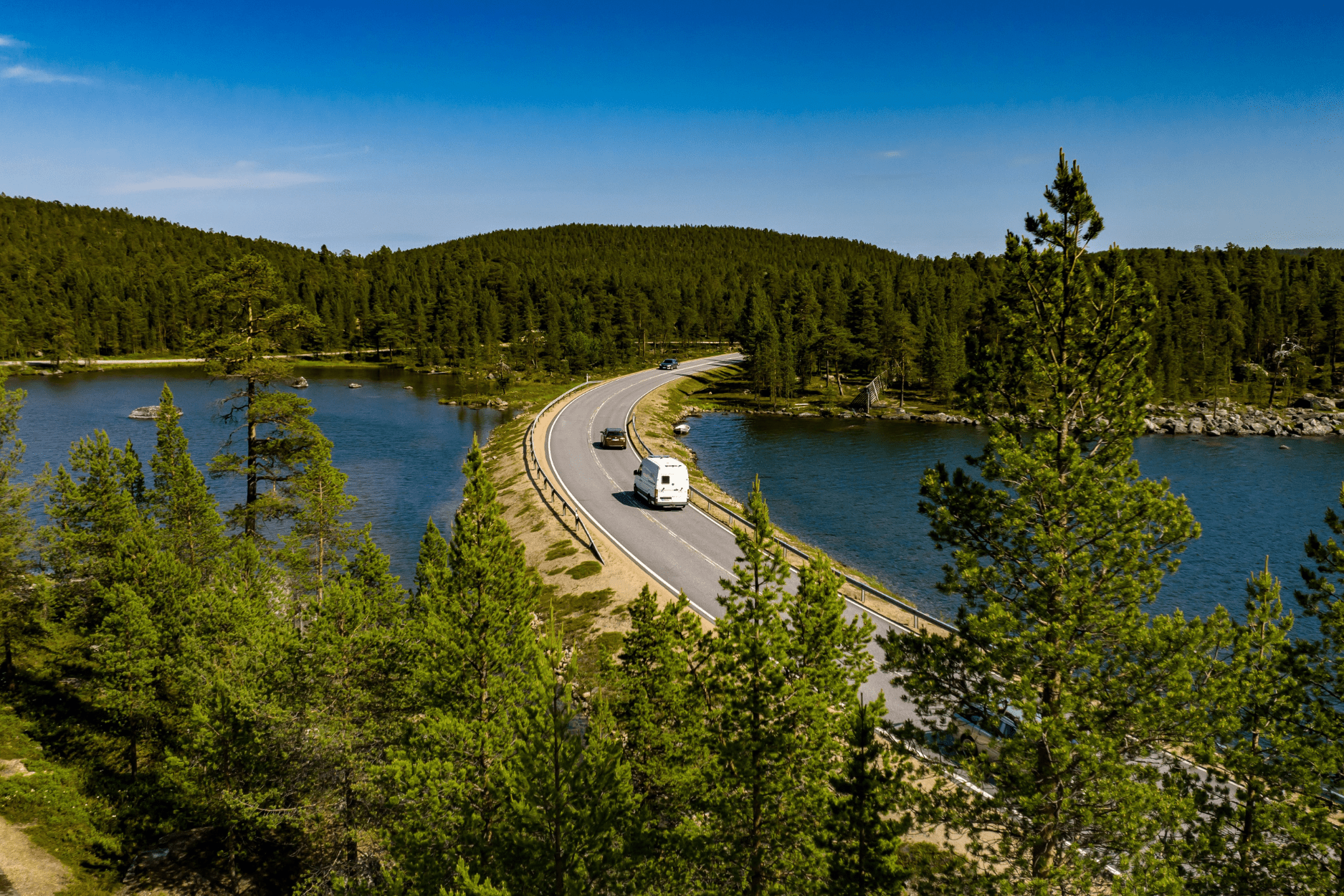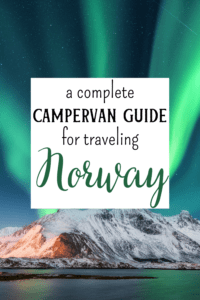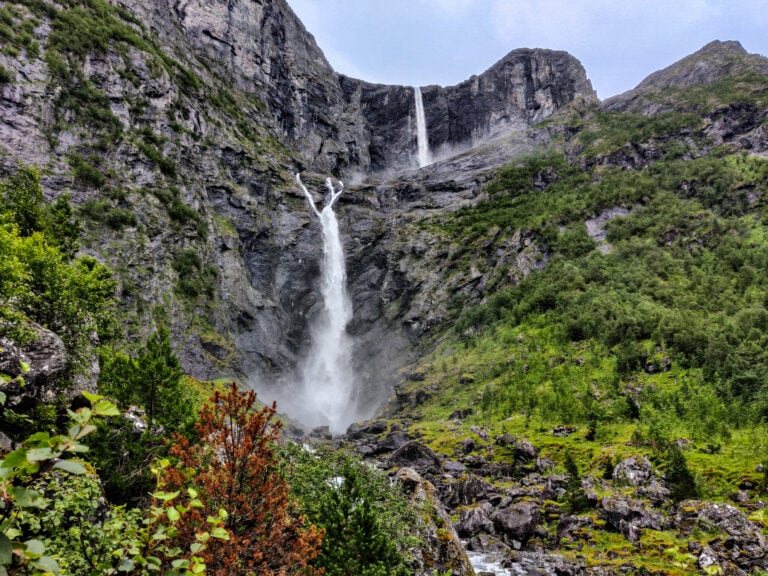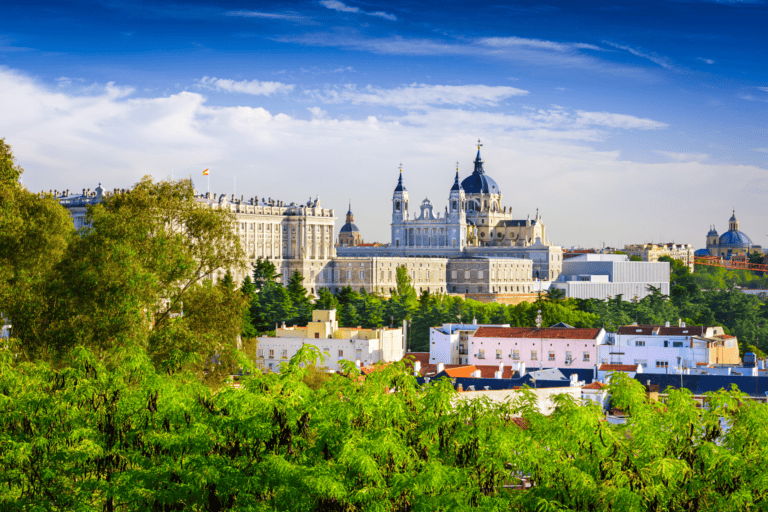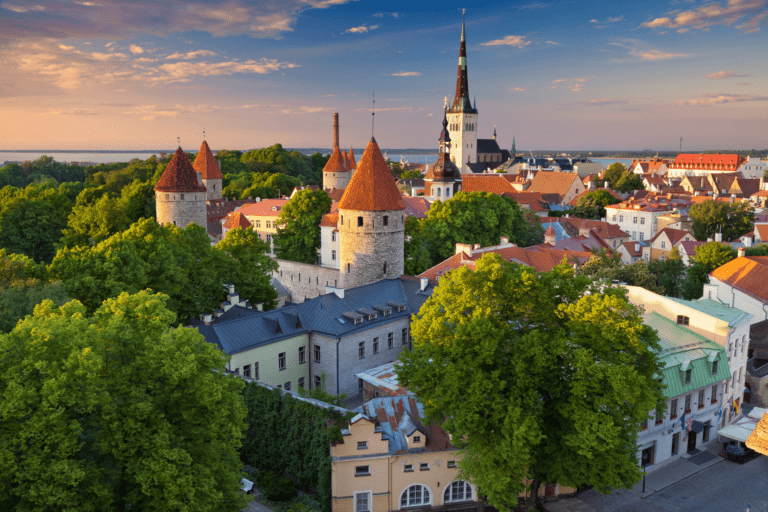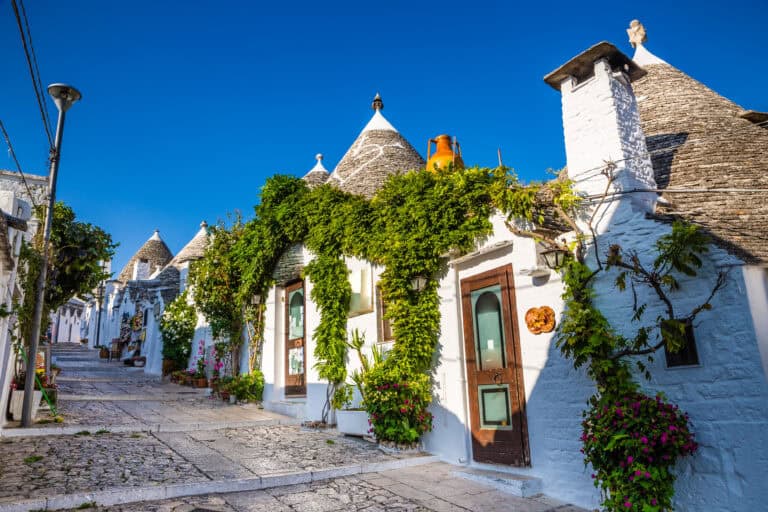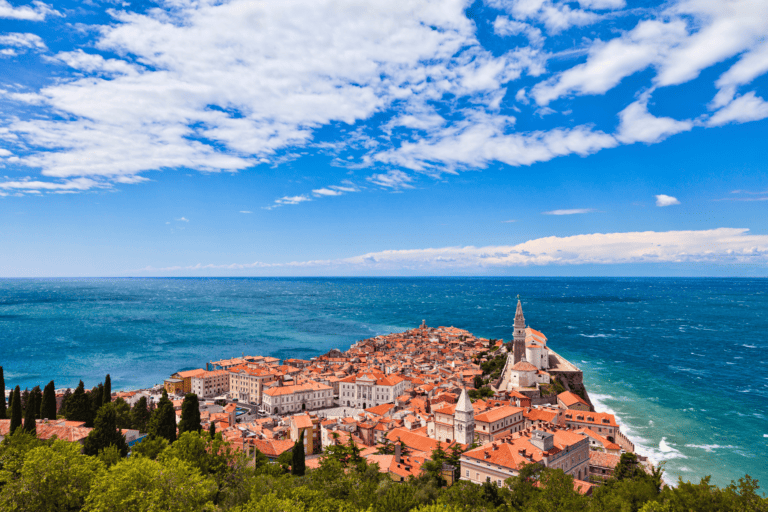Everything about van life in Norway and tips you can’t live without.
Norway is one of the most popular destinations to travel by campervan. It is allowed to park your van in a lot of different places to spend the night. But still, there are a few things you need to know before traveling to Norway by campervan.
Disclosure: This post may contain affiliate links, which means that if you purchase through one of the product links, we’ll receive a small commission at no cost to you. We only promote products and services we 100% believe in. Thank you so much for supporting us! Read more about it in our disclosure policy.
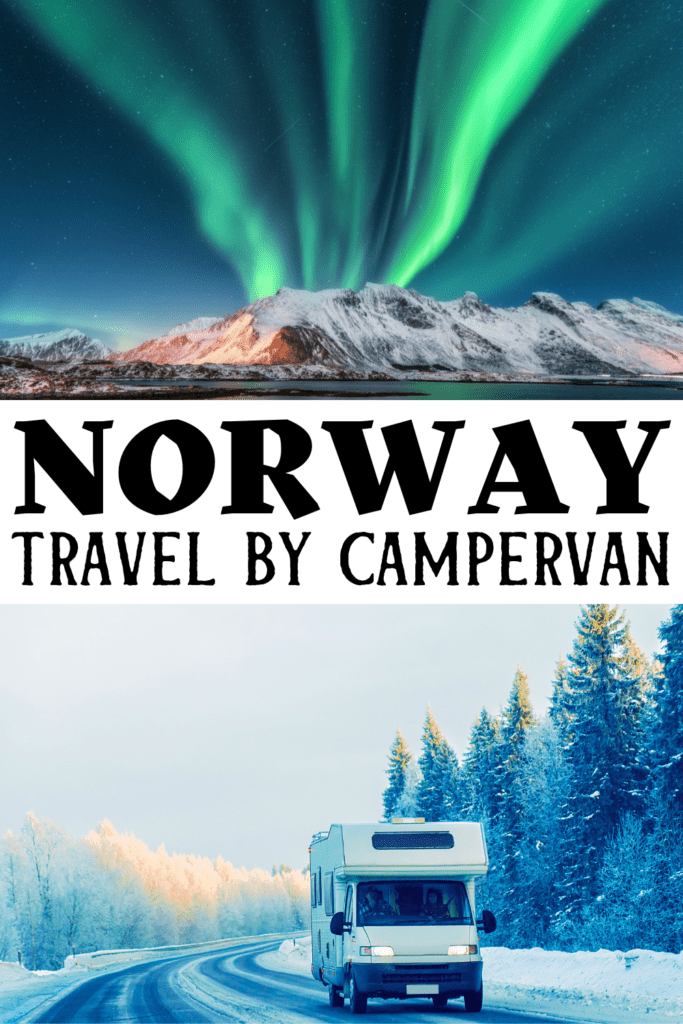
About Norway
The kingdom of Norway is a Nordic country in Europe. It’s actually the northernmost country. The spoken language in Norway is Norwegian, and most people speak English very well… Seriously… It’s almost creepy how good their English is…
The used currency in Norway is the Norwegian Krone, NOK.
$1 USD = 10,58 NOK (approx.)
1 Euro = 10,44 NOK (approx.)
Fun facts about Norway:
- Norway has a population of just over 5 million and nearly half of the Norwegian lives in the far south, around Oslo.
- Norway counts about 50000 tiny islands, carved by deep glacial fjords.
- Norway has repeatedly been ranked as the best country to live in.
- The longest tunnel in the world is located in Norway.
- Norway introduced salmon sushi to the Japanese in the eighties.
- Norway knighted a king penguin in 2008. His name’s Nils Olav.
Norway by campervan
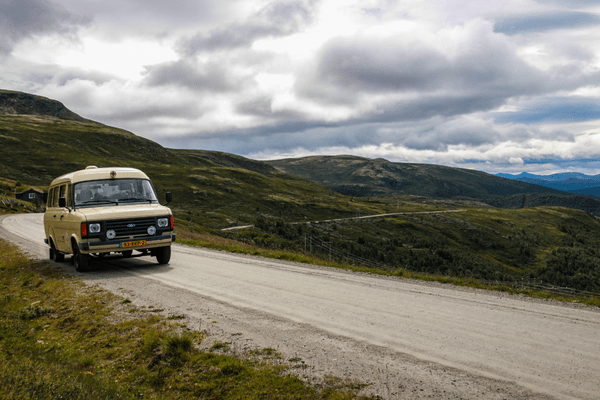
Why should you travel to Norway by campervan?
Because it’s simply worth it.
Traveling Norway by campervan has a lot of benefits:
- You’ll spend less to nothing on accommodation because wild camping is allowed and free.
- You get to sleep in places where no one else sleeps. The views you’ll get are priceless.
- It’s a great way to connect to the country and its nature.
- You have full flexibility on your trip, with no accommodations you need to check into.
When to travel Norway by campervan
Summer: May – September
From May to September, you can enjoy Norway’s beauty by campervan. When visiting in summer, you’ll notice that you’re not the only one traveling Norway by campervan. In this season, Norway’s a campervan paradise.
And no wonder why, you can save big money on accommodation by sleeping in the wild. Especially in a campervan, where you’re dry and warm. I’ll tell you more about wild camping in a bit.
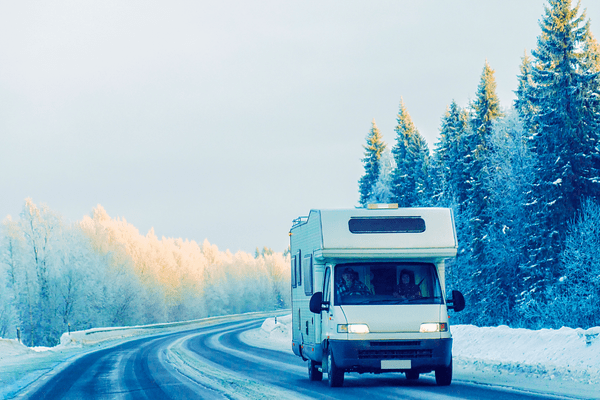
Winter: October – April
Traveling to Norway in winter by campervan is more than possible! Of course, there are more things you need to take note of, but traveling Norway in winter will be worth it!
From October, Norway becomes a snowy winter wonderland. Norway becomes a whole new place you simply have to see in your lifetime.
It will be cold. And there may be a lot of snow. But the main roads stay open and with the right equipment, you can still drive to most places.
You should prepare your van for heating and power (and make sure you don’t run out of power), winter tires, snow chains, and lots of warm clothing and blankets.
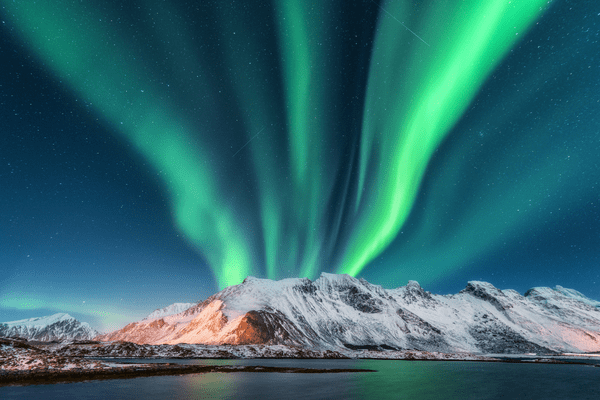
Getting to Norway with your campervan
There are many ways in which you can travel to Norway with your own campervan (assuming you’re from Europe or the UK). You’ll likely find a way of traveling that suits you best, let me take you through the options.
Bridges
You can choose to drive all the way from your home. Doesn’t matter if you’re from the UK, Spain, or Albania. Driving is always an option and likely the cheapest. But do your research on the cost, because sometimes other options may be more affordable.
When driving from any country south of Norway, you’ll have to drive through Denmark. Here’s where you’ll find 2 huge bridges. You’ll first reach the Storebaelt Bridge (Great Belt Bridge). You will need to pay a fee for crossing this bridge.
Crossing the Storebaelt bridge:
- Up to 6m <3500kg = 250 kr – €33,50
- Over 6m <3500kg = 610 kr – €82,-
- Under 10m >3500kg = 610 kr – €82,-
- Over 10m >3500kg = 965 k – €130,-
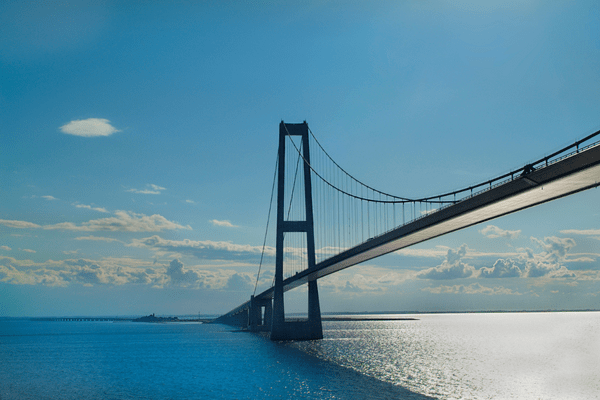
After crossing this bridge, you’ll be driving to Copenhagen, to the next bridge. The Oresund bridge will take you from Copenhagen to Malmo, over the Swedish border. This bridge also has a fee to cross.
Crossing the Oresund bridge (return tickets):
- Between 6-10m = €110
- Over 10m = €208
- Over 6m + trailer = €208
I know, the prices make you cry, but it may be your cheapest option. What’s really cool about this bridge is that it’s also a tunnel. From Copenhagen you will enter the tunnel and somewhere along the way, the tunnel becomes a bridge. It’s really cool. You have to see for yourself.
So for crossing these bridges (single way) it’ll cost you around €90,-. When looking for the cheapest option, count this price + the fuel cost and you’ll have the cost of your first option.
Ferries
For traveling to Norway there are also a lot of ferries. Let me take you through the options
Ferries from Germany
There’s a ferry from Travemunde in Germany to Malmo in Sweden. This 9-hour crossing may be a bit cheaper than taking the bridges, but you’ll still have to drive the last piece to Oslo.
The price will be variable, depending on how many people you’re traveling with and the size and weight of your vehicle. You can find prices here.
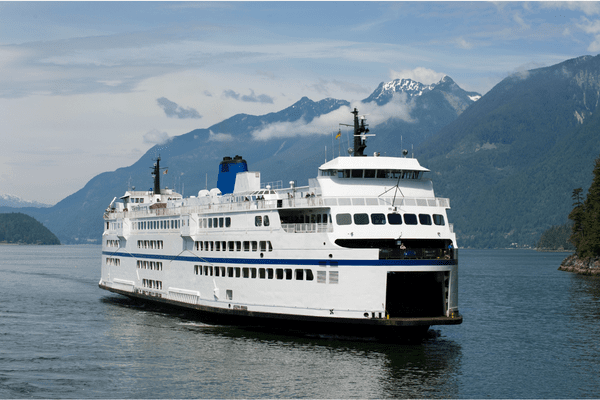
Ferries from the Netherlands
Since 2022, you can get directly to Norway from the Netherlands. You will get on the ferry in Eemshaven, Groningen and in 18 hours you’ll arrive in Kristiansand. I can’t say this is a cheap option, but you really have to find that out for yourself.
On this website, you’ll see the times and days of the crossings and you can calculate how much it’ll cost you.
Ferries from Denmark
The most popular option for taking a ferry to Norway is from Denmark. There are many options, the most popular being: Frederikshavn to Oslo, Hirtshals to Kristiansand, Larvik, Stavanger, and Bergen.
Taking a ferry from Denmark could be a wonderful option if you want to skip Oslo. You can get to western Norway in no time and it may be cheaper and more comfortable than driving the entire trip.
Visit this site to find your ferry and prices.
How we got to Norway
When we went to Norway in the summer of 2022, we balanced out every single option to find the cheapest. We went from the Netherlands with 5 people in our van.
We looked at different ferries from different places, fuel costs, tolls, and more. After hours of research, we found that driving everything and taking the bridges was the cheapest option for us.
Of course, there were 5 of us so we didn’t have to drive ridiculously long parts at once, we changed every few hours. The road to Norway took us 25 hours and back home we sat in the van for 30 hours.
But this will be different for everyone, if you’re only traveling with 2 people in total, a ferry may be the way to go. Although I’d love to help you, you have to find out your best option by yourself.
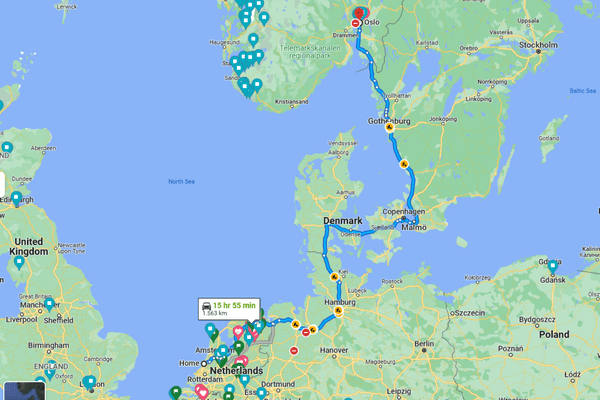
Borders
Then when you finally get to Norway, you’re gonna have to cross the border. Norway has open borders with Finland and Sweden, but note that you may get picked for a random border check.
We were lucky enough to get picked out because our oldtimer van filled with 5 young people kinda stands out. So they checked our van for drugs, money, or any other unusual thing.
When driving across the border, you may be able to drive on. But if you arrive in Norway by ferry, you will cross a hard border and you will need to complete a customs declaration form before you enter the country.
If you’re as lucky as we were and get checked, you have to have nothing unusual in your vehicle. Because they will find it. There are certain rules for crossing the Norwegian border, regarding your vehicle, importing food and alcohol, weapons, and more.
Make sure to read into it before visiting Norway.
Renting a campervan in Norway
If you’re someone who doesn’t own a campervan or you don’t live in Europe, you may want to consider renting a campervan in Norway. Because van life in Norway isn’t just practical, it’s also a unique experience.
Renting a campervan in Norway is definitely possible. In most big cities (Oslo, Bergen, Tromso, and Trondheim) there are several rental companies, renting out different kinds of campervans. You’ll find a campervan that’s suitable for you among the options.
Some trustworthy rental companies are Indie campers, campervan Norway, and arctic campers. Visit their websites for prices and locations.
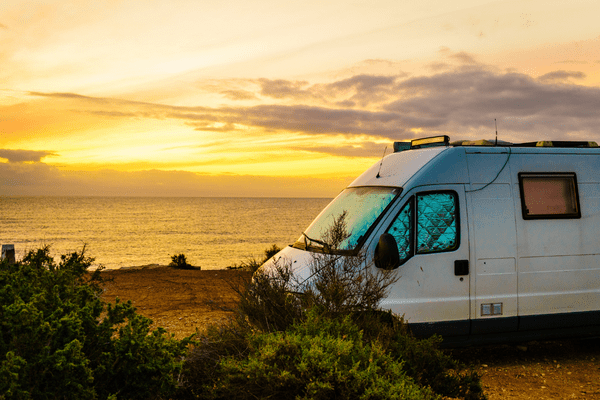
Related posts:
- Norway Road Trip Cost: A Full Guide to Traveling Norway on a Budget
- Norway 10-Day Itinerary: Everything You Have to See in Norway!
- A Full Guide to Wild Camping in Norway + Wild Camping Tips
- Norway Itinerary for an Amazing 14-day Road Trip (with Lots of Hidden Gems)
Driving in Norway
One thing you really need to keep in mind is that driving in Norway is a whole new world. At least for me, it was, but that’s because I’m from flat country; the Netherlands.
Driving through Norway will not be hard, but you need to know some of the basics:
Make way
When driving the mountainous roads of Norway it’s essential to make way for other people. There are a lot of opportunities to make some room for oncoming traffic, and you need to make use of them. They will do the same for you.
And not only oncoming traffic will need this, but if you’re a bit of a slow driver, you may also need to make way for people to pass you.
Put your lights on
In Norway, it is the law to drive with your lights on. So don’t forget to put them on every time you’re going out on the road!
Honk!
But only when driving a van or motorhome. Some curves may be unclear, so if you’re driving on a narrow road, and a bend is coming, honk. Then people will know something big’s coming and it may give you peace of mind.
The roads aren’t as scary as they seem
You’ve probably heard of the Trollstigen, which means trolls ladder. This is a Norwegian road that’s famous for all its twists and turns. Although this is the most famous one, it’s not the only one… There are many roads like this, you probably won’t be able to avoid these.
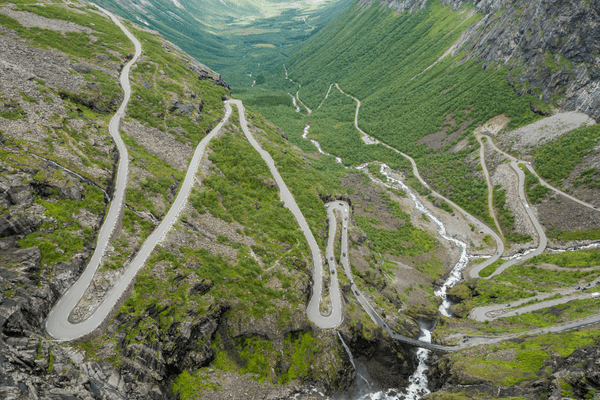
But no worries! These roads are less scary than they seem.
Everyone who’s driving these roads is alert. If you are alert and calm as well, there’s nothing to worry about. Just drive slowly and before you know it, you’ve done an incredible job of driving a mountain road!
Norwegians drive really well
Yup. Norwegians may be the best drivers of Europe. I don’t know what else to say. Almost every Norwegian is just a good driver, I thought that may be nice to know.
Campervan speed limits
Motorhomes < 3,500 kg
- Residential areas: 30 km/h
- Other built-up areas: 50 km/h
- Rural roads: 80 km/h
- Motorways: 100 km/h
Motorhomes > 3,500 kg
- Residential areas: 30 km/h
- Other built-up areas: 50 km/h
- Rural roads: 80 km/h
- Motorways: 80 km/h
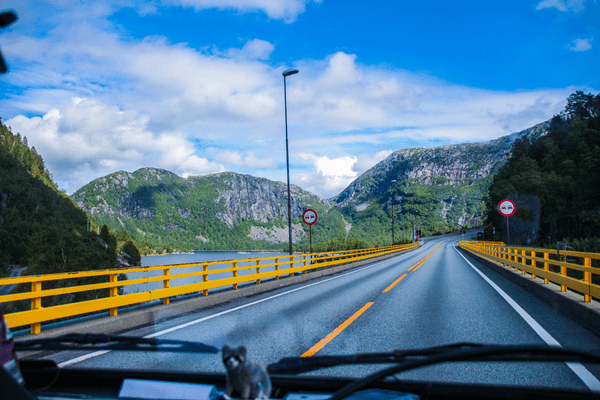
Make sure to be aware of these regular driving rules:
- Don’t drink and drive. Nope, Not even one drink.
- Don’t use your mobile phone when driving.
- Every passenger needs to wear a seatbelt.
- Stay under the speed limit.
- Always drive with at least dipped headlights on.
- Make sure your tires are in good condition.
Tolls in Norway
In Norway, you will drive on toll roads, but they aren’t quite recognizable. They will note your license plate and when you return home, there’ll be a nice little envelope with all the tolls you need to pay. So when driving through Norway you shouldn’t have to pay attention to tolls, but you will have to pay them afterward.
This also goes for ferries. In Norway there are a lot of ferries, you sometimes have to take. Most times you can pay it right there, they will walk up to your window so you can pay with a card. But sometimes if your card doesn’t work, they will register your license plate and you’ll get the bill later on.
Staying overnight
So when you’re driving through the wonderful landscapes of Norway in your campervan, I’m guessing you want to stay in your van overnight. Otherwise, you would have just taken a car.
But you can’t just stop anywhere and go to sleep. I know people sometimes make it sound like this is the case, but it’s not.
There are things you need to keep in mind and rules you need to stick to. Let me tell you about it.
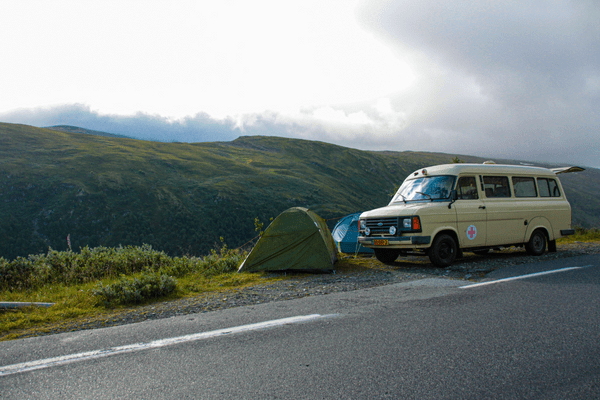
Wild camping in Norway
Wild camping is allowed in Norway.
It is allowed by the allemannsretten (loosely translated as ‘the right to roam’). This longstanding law exists because Norwegians think that everyone should be able to go out in nature without any restrictions.
This is super great, it makes that you can just go outside and pitch your tent or park your campervan and sleep! No more driving to campings, no more (expensive) accommodations. Just the freedom to sleep wherever you want! (with some limits)
You do need to find a spot though. Sometimes you’ll just randomly find a spot, but other times it’ll take you hours to drive to a certain spot, only to find out there’s a camping ban.
Finding the perfect spot
What I’m trying to say is that finding a wild camping spot isn’t always easy. I recommend installing the apps iOverlander and Park4Night. I only used iOverlander, and there were many outdated places, so you may need to use Park4Night as well.
And you have to remember that sometimes you should just settle for a lesser place. We sometimes (literally) had to sleep right next to the road, because there was no camping place near or we couldn’t find it.
Finding places is really sort of a skill you’ll have to learn. It won’t be easy at first, but the more you’re doing it, the better you become at finding spots.
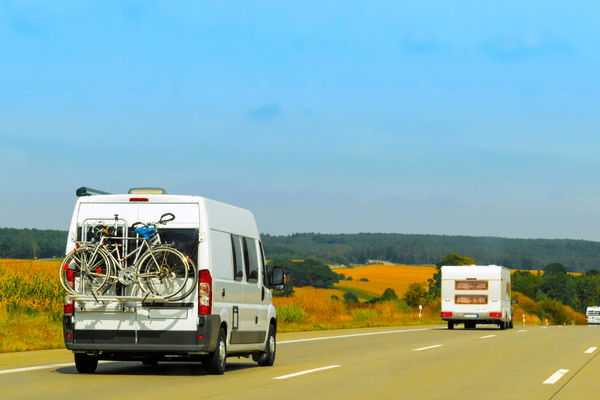
Camping bans
So wild camping is allowed in Norway and it has become one of the most popular places to go with a campervan or motorhome. Even that popular Norwegians are sometimes bothered by it. Because people with a campervan will park everywhere and anywhere.
If there’s no sign that it’s not allowed, it’s simply allowed. But sometimes you end up standing on someone’s land or a protected area. It doesn’t have to be bad if people clean up after them. But a lot of people don’t do that.
And that’s the beginning of the camping bans. Which are now placed all over the country, in specific places. You can’t know on which places they are unless you find one.
And let me tell you, you will find these camping ban signs.
But don’t worry!
There are still tons of beautiful places where you can go wild camping. They’re just a bit harder to find. But use the right apps, and you’ll learn to locate the right places.
Wild camping rules
To keep the grounds clean and the Norwegians (and travelers) happy, there are some rules you have to commit to when going wild camping.
- The right to roam only applies to uncultivated lands that are not fenced in. Like parking lots and fields.
- Keep at least 150 meters distance to the next house or hut.
- You can stay for 2 days in the same spot without permission. Make sure to move to another spot after these 2 days.
- Keep the ‘’leave no trace’’ rule in mind. You should leave the site exactly how you found it.
- Respect the ‘’no camping’’ signs.
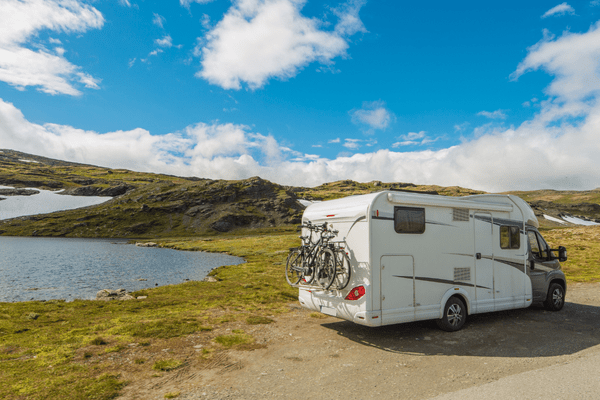
Also…
There are some rules about fishing, berry picking, and campfires:
- Fishing is allowed in salt water, the sea, and the fjords. If you want to go fishing in sweet water, you need a permit.
- Mushrooms and berries can be picked as long as it’s not on private property. Norway has a lot of delicious raspberries in summer, make sure to pick some.
- Fires are not allowed near forests from the 15th of April to the 15th of September.
- No twigs, branches, or bark from living trees may be broken or sawn off.
- In nature reserves and national parks, fire-making may be restricted or prohibited.
I know, I know, it’s a lot of rules. But please respect them, as they are there to keep nature intact
Read more about wild camping in Norway.
Campsites
A campsite in Norway is just like any other in Europe. Norway has a pretty good network of campsites, but you can expect to pay a bit of a high price for staying at a campsite. Especially knowing that wild camping is free, you may want to consider skipping campsites.
The only reason to stay at a campsite is for doing laundry or having a decent shower.
When we were in Norway we went wild camping most nights and stayed in Airbnb’s only 2 nights. One time in Oslo and 12 days later in Bergen. We made sure to book an Airbnb with a washing machine, so we could do our laundry and finally have a decent hot shower. The Airbnb in Bergen was a penthouse right behind Bryggen, so it was practical to get to and from the city without driving.
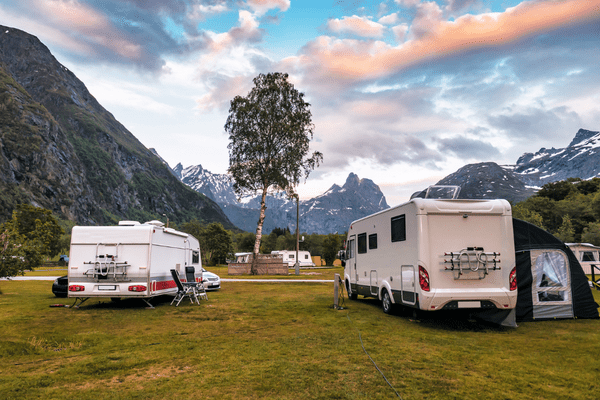
Visiting the cities
Parking
Staying on the city topic, there’s something you need to know about parking in the cities. There are many parking garages, but there’s a bit of a height problem. Those garages are mostly only 2,10 meters high.
Sometimes they claim to be higher but the second you drive in, the height drops back to 2,10 meters.
In conclusion, these parking garages aren’t made for campervans or motorhomes.
But then where should you park your van?
In Oslo, you should park your van at Parking Filipstadkaia, just make sure that all four wheels are inside the lines, otherwise, you risk getting a parking ticket.
I’m sure there are many other places in Oslo to park your van, but I couldn’t find them.
In Bergen, there’s a complex street parking system, which you can’t find much about on the internet. So that’s not really an option.
And there are a lot of places where you easily make the mistake of parking when it’s not allowed, but the signs are quite vague.
There were a lot of campervans with tickets on the front window, we also got a parking ticket. But we did manage to find a place where you could park for free, where it’s allowed (I think?).
Right behind Statsraaden Bar & Reception, there were a few spots, someone told us about, where you can park your van. You should check it out, I wouldn’t know where else to park your van in Bergen.
But remember that finding a parking spot in the city is hard. Do your research and find a place before arriving in the city.
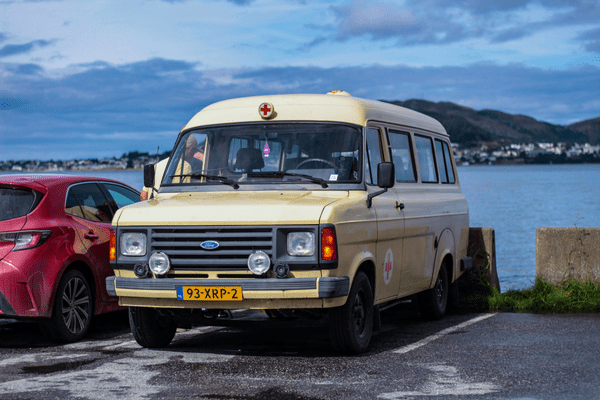
Don’t forget these documents!
When traveling to Norway, you need some documents in case of emergency. You should make a little folder and keep it in your van. The documents you’ll need are:
- An identity card or passport with at least 3 months remaining.
- A driver’s license.
- Your car/motorhome insurance documents that cover driving in all of Europe.
- Your license plate card (green card).
- Breakdown cover documentation.
- Vehicle V5 logbook (which must show the correct address).
- Trailer certification (if necessary).
- Personal travel insurance documents.
- Personal health insurance documents.
- International driving permit if required.
You don’t need a VISA when traveling to Norway.
I do recommend taking several ways to pay. Make sure to have some cash, keep your bank card close to you and leave a credit card in the van for emergencies. Also take several identity cards with you (ID card, passport, driver’s license).
You must take this emergency kit with you
When traveling Norway by campervan, you have to be prepared for anything. Because some things just go wrong.
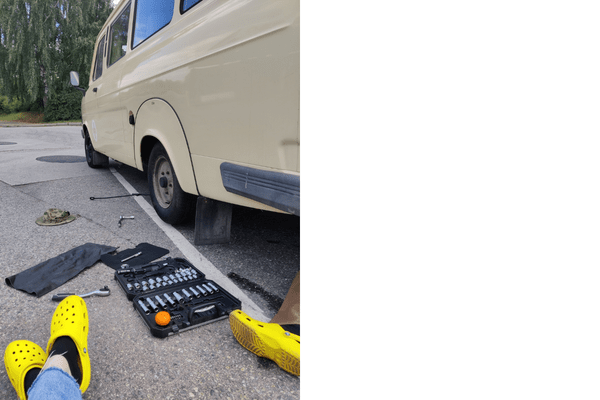
So you have to make yourself an emergency kit for inside your van, containing:
- Snow chains
- Reflective jackets
- A warning triangle
- A UK sticker (if you’re from the UK, otherwise you don’t need a sticker)
- First aid kit
- Thermal camping blanket
- Make sure you have a spare tire
- Some tools
- A jerrycan of extra fuel
You might come into a situation where you’ll need some of these things and you’re better safe than sorry. We brought snow chains in summer and ended up needing them on the first night of wild camping to get out of the mud.
Also, we ended up using a warning triangle (multiple times), a first aid kit, tools, and our spare tire was used.
Luckily we counted on things going wrong, so we were prepared. Make sure you’re prepared as well.
Final thoughts on traveling Norway by campervan
I hope I’ve covered everything you need to know about traveling Norway by campervan. It’s a lot of information, but you need to know these things. I wish I knew them earlier, it would’ve saved us a lot of time and money.
Let me know why you want to go campervanning in Norway in the comments below!
Related posts
- Norway Road Trip Cost: A Full Guide to Traveling Norway on a Budget
- Norway 10-Day Itinerary: Everything You Have to See in Norway!
- A Full Guide to Wild Camping in Norway + Wild Camping Tips
- Norway Itinerary for an Amazing 14-day Road Trip (with Lots of Hidden Gems)
